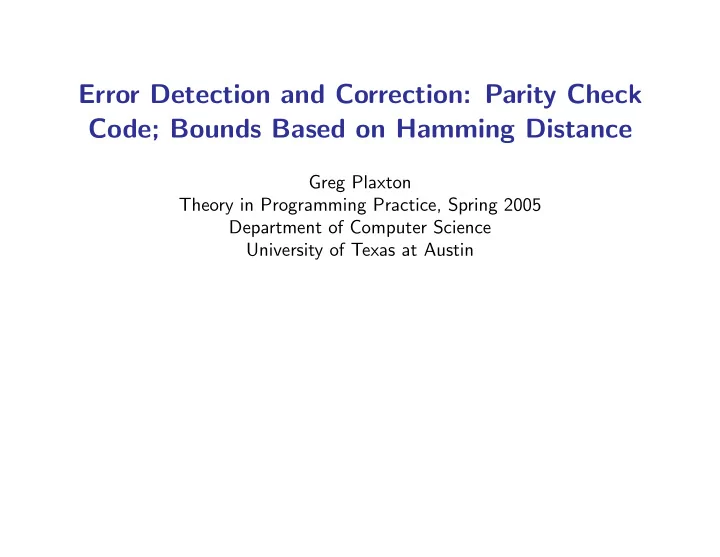

Error Detection and Correction: Parity Check Code; Bounds Based on Hamming Distance Greg Plaxton Theory in Programming Practice, Spring 2005 Department of Computer Science University of Texas at Austin
Error Detection: A Simple Example • Suppose bits are occasionally “flipped” in transmission, e.g., the message 1110001 gets corrupted to 0110011 (two bit flips) • By using a code with sufficient redundancy, we can hope to detect/correct such errors, assuming there aren’t too many of them • For example, suppose we just repeat each bit twice – If the receiver gets xx , it assumes the bit is x – If the receiver gets two different bits, it requests retransmission • The above is an example of an error detecting code (that can detect one error) • The code is not considered to be error correcting because retransmission is necessary Theory in Programming Practice, Plaxton, Spring 2005
Error Correction: A Simple Example • Suppose the sender codes each bit x as xxx • Claim: The receiver can now correct a single error • How? • How many errors can be detected? Theory in Programming Practice, Plaxton, Spring 2005
Parity Check Code • Commonly used technique for detecting a single flip • Define the parity of a bit string w as the parity (even or odd) of the number of 1 ’s in the binary representation of w • Assume a fixed block size of k • A block w is encoded as wa where the value of the “parity bit” a is chosen so that wa has even parity – Example: If w = 10101 , we send 101011 • If there are an even number of flips in transmission, the receiver gets a bit string with even parity • If there are an odd number of flips in transmission, the receiver gets a bit string with odd parity Theory in Programming Practice, Plaxton, Spring 2005
Parity Check Code: Decoding • If the receiver gets a bit string wa with even parity, it assumes that there were zero flips in transmission and outputs w – Note that the receiver fails to decode properly if the (even) number of flips is nonzero • If the receiver gets a bit string wa with odd parity, it knows that there were an odd (and hence nonzero) number of flips, so it requests retransmission – The receiver never makes a mistake in this case – Still, it is a bad case because no progress is being made • Underlying assumption: Flips are rare, so we can tolerate the corruption of the extremely small fraction of blocks with a nonzero even number of flips Theory in Programming Practice, Plaxton, Spring 2005
Parity Check Code: Analysis of a Simple Example • Note that the bit-duplicating code (where bit a is transmitted as aa ) we discussed earlier is a parity check code • Suppose we are using this code in an environment where each bit transmitted is independently flipped with probability 10 − 6 • Without the code, one bit in a million is corrupted – We use one bit to encode each bit • With the code, only about one bit in a trillion is corrupted – The retransmission rate is negligible, so on average we use slightly over each bits to encode each bit Theory in Programming Practice, Plaxton, Spring 2005
Two-Dimensional Parity Check Code • Generalization of the simple parity check code just presented • Assume each block of data to be encoded consists of mn bits • View these bits as being arranged in an m × n array (in row-major order, say) • Compute m + n + 1 parity bits – One for each row, one for each column, and one for the whole message • Send mn + m + n + 1 bits (in some fixed order) • How many errors can be detected? Theory in Programming Practice, Plaxton, Spring 2005
Hamming-Distance-Based Bounds on Error Correction and Detection • Assume we would like to encode each symbol in a given set by a distinct codeword, where all codewords have the same length k – For a given k , and some desired level of error correction or detection, how large a set of symbols can we support? – It is also interesting to consider variable-sized codewords, but we will restrict our attention to the simpler scenario of fixed-size codewords • Theorem: Let S be a set of codewords and let h be the minimum Hamming distance between any two codewords in S . Then it is possible to detect any number of errors less than h and to correct any number of errors less than h/ 2 Theory in Programming Practice, Plaxton, Spring 2005
Error Detection Bound • Let S be a set of codewords and let h be the minimum Hamming distance between any two codewords in S • Why are we guaranteed to detect any number of errors less than h ? • Is there guaranteed to be a case in which we are unable to detect h errors? Theory in Programming Practice, Plaxton, Spring 2005
Error Correction Bound • Let S be a set of codewords and let h be the minimum Hamming distance between any two codewords in S • Why are we guaranteed to be able to correct any number of errors less than h/ 2 ? • Is there guaranteed to be a case in which we are unable to correct ⌈ h/ 2 ⌉ errors? Theory in Programming Practice, Plaxton, Spring 2005
Recommend
More recommend